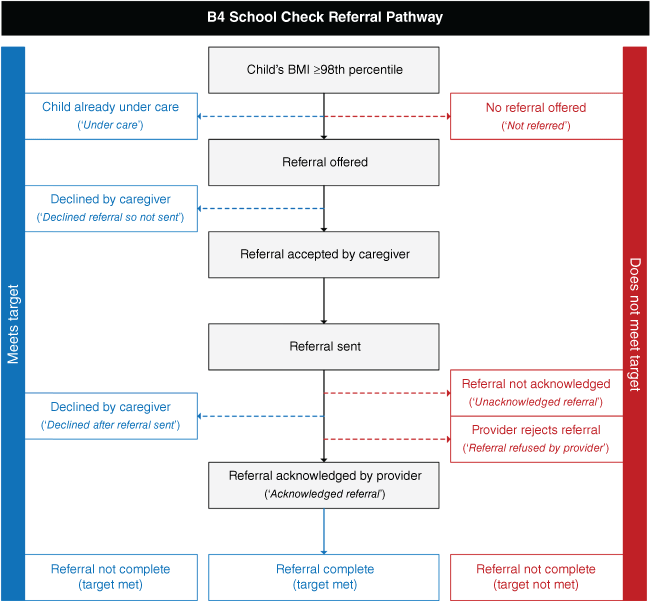Changes in referral patterns for weight in association with the preschool Raising Healthy Kids target
Tami L. Cave 1 , José G. B. Derraik 1 2 , Esther J. Willing 3 , Sarah E. Maessen 2 , Paul L. Hofman 1 , Yvonne C. Anderson 2 4 5 6 *
2 4 5 6 *
1 Liggins Institute, University of Auckland, Auckland, New Zealand.
2 Department of Paediatrics: Child and Youth Health, Faculty of Medicine and Health Sciences, University of Auckland, Auckland, New Zealand.
3 Kōhatu – Centre for Hauora Māori, Division of Health Sciences, University of Otago, Dunedin, New Zealand.
4 Curtin enAble Institute, Faculty of Health Sciences, Curtin University, Bentley, Western Australia, Australia.
5 Telethon Kids Institute, Perth Children’s Hospital, Nedlands, Western Australia, Australia.
6 Community Health, Child and Adolescent Health Service, Perth, Western Australia, Australia.
Journal of Primary Health Care 14(4) 310-317 https://doi.org/10.1071/HC22076
Published: 28 October 2022
© 2022 The Author(s) (or their employer(s)). Published by CSIRO Publishing on behalf of The Royal New Zealand College of General Practitioners. This is an open access article distributed under the Creative Commons Attribution-NonCommercial-NoDerivatives 4.0 International License (CC BY-NC-ND)
Abstract
Introduction: The ‘Raising Healthy Kids (RHK) health target’ recommended that children identified as having obesity [body mass index (BMI) ≥98th centile] through growth screening at the B4 School Check (B4SC) be offered referral for subsequent assessment and intervention.
Aim: To determine the impact of the ‘RHK health target’ on referral rates for obesity in Aotearoa New Zealand (NZ).
Methods: A retrospective audit was undertaken of 4-year-olds identified to have obesity in the B4SC programme in Taranaki and nationally in 2015–19. Key outcomes were: ‘RHK health target’ rate [proportion of children with obesity for whom District Health Boards (DHBs) applied the appropriate referral process]; Acknowledged referral rate (proportion of children with a referral for obesity whose referral was acknowledged by DHBs); and Declined referral rate (proportion of children offered a referral for obesity who declined their referral).
Results: Data were audited on 266 448 children, including 7464 in Taranaki. ‘RHK health target’ rates increased markedly between 2015–16 and 2016–17 following the health target implementation (NZ: 34–87%; P < 0.0001, Taranaki: 21–68%; P < 0.0001). Acknowledged referral rates also increased post-target nationally (56–90%; P < 0.0001), and remained high in Taranaki over the 4-year period (ranging from 89 to 99%). However, there were notably high Declined referral rates across NZ (26–31%) and in Taranaki (although variable: 38–69%).
Discussions: The ‘RHK health target’s’ focus on referral rather than intervention uptake limited the policy’s impact on improving preschool obesity. Future policy should focus on ensuring access to multidisciplinary intervention programmes across NZ to support healthy lifestyle change.
Keywords: B4 School Check, childhood obesity intervention, health target, healthy lifestyle change, multidisciplinary intervention programme, preschool, referral, Whānau Pakari.
| WHAP GAP THIS FILLS |
| What is already known: The intent of the ‘Raising Healthy Kids (RHK) health target’ was to increase referrals for children identified as having obesity at the B4 School Check, but its impact on referrals has not been previously reported. |
| What this study adds: After the introduction of the ‘RHK health target’, both the Ministry of Health-defined ‘RHK health target’ rate and the Acknowledged referral rate increased, nationally and in Taranaki. A substantial proportion of referrals were declined by the families they were offered to; understanding why has been the subject of further research. |
Introduction
Halting the rise of childhood overweight by 2025 is one of the World Health Organization’s (WHO) global nutrition targets.1 Excess weight tracks from childhood into adolescence and adulthood,2,3 and is associated with long-term adverse outcomes;4,5 therefore, addressing this issue in early childhood is important. However, curbing increasing rates of childhood overweight and obesity remains a considerable challenge, with estimates showing no progress in curbing rates of overweight in any country-income group since 2000.6 Currently, an estimated 38.3 million children aged <5 years are affected by overweight or obesity globally,6 and it appears that insufficient headway has been made to achieve the WHO’s childhood overweight target.6
Aotearoa New Zealand (henceforth referred to as NZ) has one of the highest rates of childhood overweight and obesity among the Organisation for Economic Co-operation and Development (OECD) and European Union countries.7 According to the NZ Health Survey, 13% of children aged 2–14 years are affected by obesity.8 Indigenous Māori children (18%), Pacific children (35%), and children residing in the most socioeconomically deprived areas (20%) consistently experience much higher obesity rates than children from other ethnic groups and those living in areas of lowest deprivation.8 For children aged 2–4 years, obesity prevalence sits at 6%.8
Growth in NZ preschool children has been monitored since the implementation of the B4 School Check (B4SC) programme in 2008.9 The B4SC is a nurse-led health check of 4-year-olds including height and weight measurements, which screens for and addresses any potential health, developmental, behavioural or social problems prior to school entry.10 Therefore, the B4SC offers an opportunity to identify weight concerns and families in need of appropriate weight management services.11 With population-based research showing that the most rapid weight gain among adolescents affected by overweight or obesity occurs during the preschool years,12 this is a critical period to screen for excess weight. Since its introduction, the B4SC has also provided the most comprehensive picture of overweight and obesity in the NZ preschool population. Research suggests levels of childhood overweight and obesity declined slightly in NZ 4-year-old children between 2011 and 2019.13 Despite this, approximately 6700 (12.5%) 4-year-old children were estimated to be affected by obesity in 2018–19.13
In 2016, a new national health target known as the ‘Raising Healthy Kids (RHK) target’ was embedded within the B4SC programme by the NZ Government, stating that ‘by December 2017, 95% of obese children identified in the B4SC programme will be offered a referral to a health professional for clinical assessment and family-based nutrition, activity and lifestyle interventions’.14, p. 3 The expectation was that any children identified with obesity at the B4SC would be referred on for further assessment and management15 – a process mandated by reporting to the Ministry of Health (MoH) for the ‘RHK health target’.16 However, there was no standardised process for management nationwide, so management may have included general practitioner, community dietitian, public health or practice nurse, or multidisciplinary team input, depending on what was available in the region a child was referred. Within the Taranaki District Health Board (DHB) (a mixed urban–rural region of NZ), Whānau Pakari, a region-wide multidisciplinary assessment and intervention programme for healthy lifestyle change, was available to support children and adolescents identified with obesity over the time of the audit. It was able to accept referrals from the new target into its existing programme.17
Quarterly progress towards the ‘RHK health target’ within NZ’s 20 DHBs and nationally was reported by the MoH. Although the first quarter of national reporting (quarter one 2017–18) did not meet the 95% threshold, the target was met consistently through to the fourth quarter of 2019–20.18 The ‘RHK health target’ monitoring was relaxed in June 2018, with the NZ Government calling for a new set of performance measures to improve health outcomes. Nonetheless, DHBs continued to report against the current suite of health targets (including the ‘RHK health target’) while new measures were under development. The national health targets have since been replaced by a Health System Indicators Framework, which was implemented during 2021–22.19
Despite national reporting, to our knowledge, there has been no published data describing the impact of the national ‘RHK health target’ on referral rates for preschool children identified with obesity before and after its introduction. This study aimed to determine the impact of the ‘RHK health target’ over time on referral rates for preschool children identified with obesity at the B4SC in Taranaki, and nationally.
Methods
A retrospective audit was undertaken of data on preschool children screened for growth concerns within the fiscal years (1 July to 30 June) from 2015–16 to 2019–20 in the B4SC programme, both in Taranaki and nationally. The study period covered years before and after the introduction of the ‘RHK health target’. The audit focused on children identified with obesity [ie body mass index (BMI) ≥98th centile]. This BMI cut-off is recommended for use by the MoH nationally for defining obesity for children aged 0–5 years.20,21 For Taranaki and NZ demographic information (as per Census 2018 data),22 see Supplementary Table S1.
Data collection
Data were obtained from the NZ MoH B4SC National Information System via MoH analysts. Data were unidentifiable and included children’s: screening month and year, DHB, sex, age, ethnicity (Māori/non-Māori, as provided by the MoH), height, weight, BMI, BMI percentile group, and obesity referral outcomes (described below). BMI percentile groupings were based on WHO Child Growth Standards.23 Exclusion criteria were: missing referral information; missing height or weight information; extreme BMI value (ie <5 kg/m2 or >60 kg/m2); or a health check outside the health target age range (ie <48 months or >60 months).
B4SC obesity referral outcomes
Every child with a completed growth check identified as having obesity was assigned one of the following referral outcomes (Fig. 1). A ‘referral’ is a referral for obesity to a general practitioner, community dietitian, public health nurse, practice nurse, or a multidisciplinary team. For ease of understanding, these outcomes are labelled in simple terms, with the corresponding MoH terminology (drawn from MoH B4SC reports24) provided in brackets.
Under care – the child was already under the care of a general practitioner and/or paediatrician for weight-related concerns, so no referral was sent;
Not referred – no referral offered to caregivers, so none was sent to a health professional/service provider;
Declined referral so not sent [‘Referral declined (growth outcome)’] – the child was not under care for weight-related concerns, and the caregiver declined the referral so none was sent;
Declined after referral sent [‘Referral declined (referral status)’] – the child was not under care for weight-related concerns, a referral was sent to a health professional/service provider, but the caregiver subsequently declined the referral;
Unacknowledged referral (‘Referral sent and not acknowledged’) – the child’s caregiver accepted the referral for their child, which was sent to a health professional/service provider, who did not acknowledge within the required timeframe;
Referral refused by provider (‘Not referred – referral refused by service provider’) – a referral was sent to a health professional/service provider, but was refused by the provider; and
Acknowledged referral (‘Referral sent and acknowledged’) – the child’s caregiver accepted the referral for their child, which was sent to a health professional/service provider, who acknowledged it within the required timeframe.
For the purposes of ‘RHK health target’ reporting, both Declined referral so not sent and Declined after referral sent were aggregated and counted as a ‘declined referral’.
Two changes to the MoH’s methodology occurred over the study period. First, prior to the introduction of the ‘RHK health target’ and associated reporting requirement, it was not mandatory for a referral for obesity to be made to a health professional/service provider, but after the health target’s introduction, this became a requirement for the referral to be recognised under ‘RHK health target’ reporting. Second, the referral acknowledgement period was 60 days prior to the introduction of the ‘RHK health target’, and was reduced to 30 days with the target’s introduction.
Calculations of B4SC obesity referral outcome rates
Three outcomes were examined as part of this study: (1) the ‘RHK health target’ rate (as defined by the MoH); (2) the Acknowledged referral rate; and (3) the Declined referral rate (again, as defined by the MoH).
The ‘RHK health target’ rate was defined as the proportion of children identified with obesity, for whom DHBs applied the appropriate referral process for subsequent assessment and intervention (see Fig. 1). The method ascribed by the MoH for calculating the ‘RHK health target’ rate for each DHB was as follows, with the denominator representing all children identified with obesity in the checks during the designated reporting period:
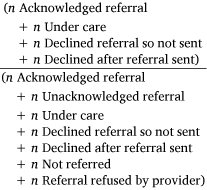
However, we questioned whether a caregiver declining a referral should be included within the numerator definition of this calculation. This provided the rationale for separately examining the rates of children with an Acknowledged referral and Declined referral outcome for Taranaki and NZ, both overall and by ethnicity. These rates were calculated using the following methods:
Acknowledged referral rate:

The Acknowledged referral rate was calculated as a percentage from children identified with obesity who actually had a referral sent to a health professional/service provider, so the denominator did not include children with a referral outcome of Under care, Declined referral so not sent, or Not referred.
Declined referral rate (as per MoH methodology):24
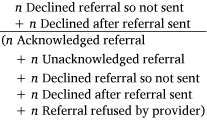
Similarly, the Declined referral rate denominator did not include children with a referral type of Under care or Not referred, as it was calculated as a percentage from all children identified with obesity from completed checks in the designated reporting period who were also offered a referral.
It is important to note that the referral outcome rates were derived from growth check data referral outcome counts for a given fiscal year.
Statistical analyses
Statistical comparisons only compared rates in the two adjacent fiscal years immediately before and after the introduction of the ‘RHK health target’, using Fisher’s exact tests. Similar analyses examined differences in declined rates among Māori children. Tests were two-tailed, carried out using Minitab v16 (Pennsylvania State University, State College, Pennsylvania, USA).
Ethics
Ethics review for this study was not required under regulations of the National Ethics Advisory Committee 2012 for programme evaluation/audit. The Whānau Pakari randomised controlled trial was granted ethics approval by the Central Health and Disability Ethics Committee (New Zealand) (CEN/11/09/054).
Results
Referral outcome rates over the study period are summarised in Table 1. Nationally, 266 448 children were assessed, including 7464 children in Taranaki.
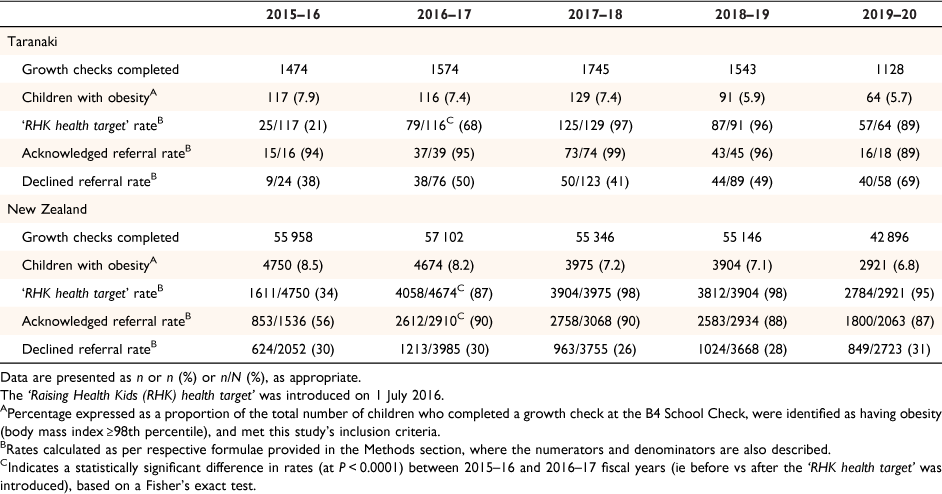
|
There was an increase in the ‘RHK health target’ rate for all preschool children between 2015–16 and 2016–17 after the implementation of the health target, in Taranaki (from 21 to 68%; P < 0.0001) and across NZ (34–87%; P < 0.0001) (Table 1, Fig. 2a, d). Patterns were largely similar irrespective of ethnicity, in Taranaki and across NZ.
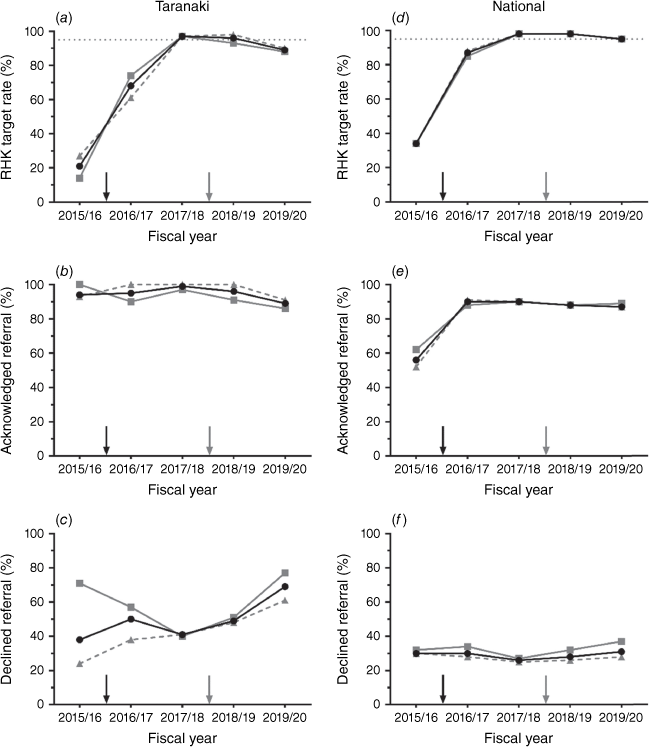
|
The Acknowledged referral rates for Taranaki and NZ are presented in Fig. 2b, e. In Taranaki (referring to the Whānau Pakari programme), the rate was maintained >90% for the majority of the study period (Fig. 2b). Nationally, there was an increase in the Acknowledged referral rate (from 56 to 90%; P < 0.0001) (Table 1) for all children after the target’s introduction, with rates remaining high throughout the remainder of the study (Fig. 2e). As with the ‘RHK health target’ rate, little difference was observed by ethnicity, in Taranaki or across NZ.
Fig. 2c, f present the Declined referral rates. Rates for Taranaki were variable (range 38–69%) (Fig. 2c), likely explained by the comparatively lower total numbers of children with obesity in the B4SC offered a referral in the region (Table 1). This was particularly so for Māori children, with a denominator ranging from 7 to 57 children (data not shown). For this group, rate of declined referrals dropped from 59% over the first 2 years (2015–16 to 2016–17; 32/54) to 40% in 2017–18 (23/57; P = 0.048) following the introduction of the health target; however, declined rates increased once again to 77% in 2019–20 (23/30; P < 0.001 vs 2017-18) after removal of the health target (Fig. 2c). Nonetheless, the results showed high Declined referral rates in Taranaki for all preschool children.
Nationally, little difference was observed between the Declined referral rates for preschool children, regardless of ethnicity (Fig. 2f). There was minimal variation in this rate across the study for all preschool children (range 26–31%) (Table 1).
Discussion
In this audit of B4SC obesity referral data, key findings were that the health target increased the ‘RHK health target’ rate (as defined by the MoH) in Taranaki and nationally. The target also increased the Acknowledged referral rate across NZ. Importantly, however, and not immediately obvious from the ‘RHK health target’ rates, a substantial proportion of caregivers declined the B4SC obesity referral in Taranaki and nationally. Finally, this audit showed little difference in the majority of the calculated referral rates between Māori and non-Māori children.
This audit highlighted important issues with evaluation of the ‘RHK health target’. As defined by the MoH, the ‘RHK health target’ rate included families that declined an obesity referral at the B4SC in the numerator, alongside acknowledged referrals and those already under care for weight concerns. Therefore, although the health target was met and taken as evidence of good performance by DHBs, increases in the ‘RHK health target’ rate did not require that more preschool children with obesity were actually referred for further assessment and intervention.
Analysing the Acknowledged referral rates for children with obesity, including only those who actually had a referral sent to a health professional/service provider, showed that the establishment of the health target resulted in an increase in this rate nationally. However, as a referral-based target, limited attention was paid to engagement with a relevant health professional or intervention services after referral. It is unknown whether referrals resulted in improvements in weight status; therefore, the ‘RHK health target’ in isolation was a missed opportunity to achieve meaningful health improvements in this age group and support development of multidisciplinary intervention programmes for children affected by weight nationwide (given the lack of a consistent approach to child obesity management across the country).
These findings have implications for health policy. It is recommended that any target or performance measure in this area should focus on the uptake of a multidisciplinary programme by families post-referral. Evidence indicates that multi-component interventions (including diet, physical activity, and behavioural components) are more successful when compared with usual care, enhanced usual care, or control groups in the management of overweight or obesity for children aged <6 years.25 However, there remains a paucity of research in this area, particularly for preschool children from groups over-represented in obesity statistics. Family-focused, multidisciplinary assessment and intervention programmes for healthy lifestyle change across the paediatric life-course should be made available nationwide. Ideally, regional uptake of these programmes should be measured and uptake data collated nationally. One of the Government’s new Health System Indicators Framework priorities is ‘Improving child wellbeing’; however, no indicator related to child obesity features under this priority. This represents a shift backwards in efforts to address this critical public health issue.
Despite the limitations of the ‘RHK health target’, the Acknowledged referral results for Taranaki demonstrated the impact of a pre-existing referral pathway in the region. Whānau Pakari was well-equipped to immediately absorb additional referrals in response to the new health target, offering preschool children a comprehensive weight-related assessment and support within its multidisciplinary assessment and intervention programme, with appropriate age-related offerings.
The finding of similar Acknowledged referral rates for Māori and non-Māori children across Taranaki and NZ is of importance, showing that the health target maintained relatively equitable referral results for Māori children. It is essential that childhood obesity policy considers inequities experienced by Māori children in its design. However, without monitoring the uptake of support beyond the B4SC referral, the level of engagement is unknown for specific population groups in NZ. Though not a focus of this study, many Pacific children experience social disadvantage and very high rates of obesity.26
Introduction of the ‘RHK health target’ appeared to have little impact on national Declined referral rates (as a percentage of those with a referral offered). Nevertheless, rates for both Taranaki and NZ throughout the study demonstrated many caregivers declining referral for further assessment/intervention for weight issues in their children (Taranaki 38–69%; and NZ 26–31%). Higher Declined referral rates were observed in Taranaki, but with a small sample size, it is difficult to interpret the impact of the health target on these data. It is important to understand the reasons why caregivers decline weight-related support for their preschool children. Qualitative research with caregivers of preschool children referred for weight issues in Taranaki found that caregiver perceptions were critical to influencing their acceptance and management of their child’s weight issues, and crucially, that the referral experience to a healthy lifestyle programme was important for determining future engagement.27
Strengths of this study included an assessment of the impact of the ‘RHK health target’ in multiple ways – through the examination of the ‘RHK health target’ rate, and the Acknowledged and Declined referral rates in Taranaki and nationally. Including ethnicity assisted with understanding the impact of the health target for Māori. Direct comparisons were not possible between Taranaki and national data as both represented different referral/support pathways in response to the health target. In Taranaki, Whānau Pakari provided a multidisciplinary home-based assessment and intervention programme. In contrast, national data were more likely to represent a conventional approach to the management of child obesity, with initial referral to a general practitioner for assessment, and subsequent referral to child obesity services where available.
Conclusions
Likely unknown to the majority of caregivers involved in this research, the ‘RHK health target’ directly influenced the referral process for their preschool children. This audit is the first to review the impact of the ‘RHK health target’. The target resulted in increased referral rates of preschool children identified with obesity at the B4SC, but the focus on referral rather than engagement with an intervention meant the opportunity to intervene with unhealthy weight in this age group was missed. Childhood obesity policy must focus on outcomes that are more aligned with meaningful reduction in childhood obesity for preschool children, and support the development of family-focused, multidisciplinary assessment and intervention programmes for healthy lifestyle change nationally.
Supplementary material
Supplementary material is available online.
Data availability
The data that support this study were obtained from the New Zealand Ministry of Health by permission.
Conflicts of interest
The authors have no conflicts of interest that are directly or indirectly relevant to the content of this research. The funders had no role in study design; in the collection, analysis, and interpretation of data; in the writing of the manuscript; and in the decision to submit the article for publication.
Declaration of funding
This work was supported by the Health Research Council of New Zealand (Māori Masters Scholarship) and the Maurice and Phyllis Paykel Trust. Dr Derraik and Dr Maessen acknowledge salary support from Tamariki Pakari Child Health and Wellbeing Trust.
Author contributions
Ms. Cave: conceptualisation, methodology, investigation, formal analysis, writing – original draft, writing – critical review and editing. Dr. Derraik: formal analysis, writing – critical review and editing, visualisation. Dr. Willing: supervision, conceptualisation, methodology, writing – critical review and editing. Dr Maessen: writing – critical review and editing. Professor Hofman: writing – critical review and editing. Dr. Anderson: supervision, conceptualisation, methodology, writing – critical review and editing, funding acquisition. All authors critically appraised the manuscript and approved the final manuscript to be submitted.
Acknowledgements
We acknowledge the children and families indirectly involved in this research. Furthermore, we acknowledge Sheetalpreet Singh at the Ministry of Health for providing the summary data from the B4SC. The opinions presented in this publication are the authors own and do not represent an official view of the Ministry of Health.
References
[1] World Health Organization. Global targets 2025. To improve maternal, infant and young child nutrition. 2022. Available at https://www.who.int/teams/nutrition-and-food-safety/global-targets-2025 [Accessed 21 August 2022].[2] World Health Organization. Interim Report of the Commission on Ending Childhood Obesity. Geneva: World Health Organization; 2015.
[3] The NS, Suchindran C, North KE, et al. Association of adolescent obesity with risk of severe obesity in adulthood. JAMA 2010; 304 2042–2047.
| Association of adolescent obesity with risk of severe obesity in adulthood.Crossref | GoogleScholarGoogle Scholar |
[4] Kim J, Lee I, Lim S. Overweight or obesity in children aged 0 to 6 and the risk of adult metabolic syndrome: A systematic review and meta-analysis. J Clin Nurs 2017; 26 3869–3880.
| Overweight or obesity in children aged 0 to 6 and the risk of adult metabolic syndrome: A systematic review and meta-analysis.Crossref | GoogleScholarGoogle Scholar |
[5] Park MH, Falconer C, Viner RM, et al. The impact of childhood obesity on morbidity and mortality in adulthood: a systematic review. Obes Rev 2012; 13 985–1000.
| The impact of childhood obesity on morbidity and mortality in adulthood: a systematic review.Crossref | GoogleScholarGoogle Scholar |
[6] United Nations Children’s Fund, World Health Organization, International Bank for Reconstruction and Development/The World Bank. Levels and Trends in Child Malnutrition: Key Findings of the 2020 Edition of the Joint Child Malnutrition Estimates. Geneva: World Health Organization; 2020.
[7] UNICEF. The State of the World’s Children 2019. Children, Food and Nutrition: Growing Well in a Changing World. New York: UNICEF; 2019.
[8] Ministry of Health. Tier 1 Statistics 2020/2021: New Zealand Health Survey. Wellington: Ministry of Health; 2021.
[9] Gibb S, Milne B, Shackleton N, et al. How universal are universal preschool health checks? An observational study using routine data from New Zealand’s B4 School Check. BMJ Open 2019; 9 e025535
| How universal are universal preschool health checks? An observational study using routine data from New Zealand’s B4 School Check.Crossref | GoogleScholarGoogle Scholar |
[10] Ministry of Health. B4 School Check. 2015. Available at https://www.health.govt.nz/our-work/life-stages/child-health/b4-school-check [Accessed 21 August 2022].
[11] Ministry of Health. Clinical Guidelines for Weight Management in New Zealand Children and Young People. Wellington: Ministry of Health; 2016.
[12] Geserick M, Vogel M, Gausche R, et al. Acceleration of BMI in early childhood and risk of sustained obesity. N Engl J Med 2018; 379 1303–1312.
| Acceleration of BMI in early childhood and risk of sustained obesity.Crossref | GoogleScholarGoogle Scholar |
[13] Daniels L, Taylor BJ, Taylor RW, et al. Further reductions in the prevalence of obesity in 4-year-old New Zealand children from 2017 to 2019. Int J Obes (Lond) 2022; 46 1176–1187.
| Further reductions in the prevalence of obesity in 4-year-old New Zealand children from 2017 to 2019.Crossref | GoogleScholarGoogle Scholar |
[14] Ministry of Health. Children and Young People Living Well and Staying Well: New Zealand Childhood Obesity Programme Baseline Report. Wellington: Ministry of Health; 2017.
[15] Ministry of Health. Well Child/Tamariki Ora Programme Practitioner Handbook: Supporting Families and Whānau to Promote Their Child’s Health and Development – Revised 2014. Wellington: Ministry of Health; 2013.
[16] Moir C, Jones V. Experience of nurses measuring preschool body mass index for the health target: Raising Healthy Kids. J Prim Health Care 2019; 11 275–282.
| Experience of nurses measuring preschool body mass index for the health target: Raising Healthy Kids.Crossref | GoogleScholarGoogle Scholar |
[17] Anderson YC, Wynter LE, Moller KR, et al. The effect of a multi-disciplinary obesity intervention compared to usual practice in those ready to make lifestyle changes: design and rationale of Whanau Pakari. BMC Obes 2015; 2 41
| The effect of a multi-disciplinary obesity intervention compared to usual practice in those ready to make lifestyle changes: design and rationale of Whanau Pakari.Crossref | GoogleScholarGoogle Scholar |
[18] Ministry of Health. How is my DHB performing? Health targets. 2022. Available at https://www.health.govt.nz/new-zealand-health-system/health-targets/how-my-dhb-performing-2017-18 [Accessed 21 August 2022].
[19] Ministry of Health. Health targets. 2021. Available at https://www.health.govt.nz/new-zealand-health-system/health-targets [Accessed 21 August 2022].
[20] Cole TJ. A chart to link child centiles of body mass index, weight and height. Eur J Clin Nutr 2002; 56 1194–1199.
| A chart to link child centiles of body mass index, weight and height.Crossref | GoogleScholarGoogle Scholar |
[21] Ministry of Health. Fact Sheet 6: Plotting and assessing infants and toddlers up to age five years. 2010. Available at http://www.health.govt.nz/system/files/documents/pages/factsheet-6-growth-charts-well-child.pdf [Accessed 21 August 2022].
[22] Statistics New Zealand. Census data 2018: Age and sex by ethnic group (grouped total responses), for census usually resident population counts. 2019. Available at http://nzdotstat.stats.govt.nz/wbos/Index.aspx?DataSetCode=TABLECODE8277# [Accessed 21 August 2022].
[23] World Health Organization Multicentre Growth Reference Study Group. WHO Child Growth Standards: Length/Height-for-Age, Weight-for-Age, Weight-for-Length, Weight-for-Height and Body Mass Index-for-Age: Methods and Development. Geneva: World Health Organization; 2006.
[24] Ministry of Health. Before School Checks - Monthly Report to the End of October 2018. Health Target - Growth (Recent Six Months). Wellington: Ministry of Health; 2018.
[25] Colquitt JL, Loveman E, O’Malley C, et al. Diet, physical activity, and behavioural interventions for the treatment of overweight or obesity in preschool children up to the age of 6 years. Cochrane Database Syst Rev 2016; 3 CD012105
| Diet, physical activity, and behavioural interventions for the treatment of overweight or obesity in preschool children up to the age of 6 years.Crossref | GoogleScholarGoogle Scholar |
[26] Ministry of Health. Annual Update of Key Results 2018/19: New Zealand Health Survey. Wellington: Ministry of Health; 2019.
[27] Cave TL, Derraik JGB, Willing EJ, et al. Caregiver perceptions of weight in preschool children, and determinants of engagement in a multidisciplinary intervention service for weight issues. Obes Res Clin Pract 2021; 15 262–267.
| Caregiver perceptions of weight in preschool children, and determinants of engagement in a multidisciplinary intervention service for weight issues.Crossref | GoogleScholarGoogle Scholar |


